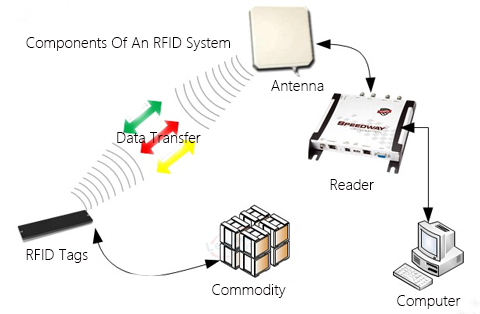Components Of An RFID System
The RFID System is mainly composed of
RFID Tags,
RFID Readers and
RFID Antennas. Generally, the data collected by the readers are transmitted to the back-end system for processing.

1. RFID tags
An RFID Tag, also known as a transponder, is a small device that can be attached to an object so that the object could be identified and tracked. The tag is composed of a microchip, an antenna, and a substrate or encapsulation material. The microchip stores data whereas the antenna transmits and receives the data. The microchip and antenna attached to the substrate are referred to as the inlay. The inlay is encased in protective material such as paper, plastic, or a film. The size of a tag is usually determined by the size of its antenna because the microchip is usually very small in size (Brown 2007). Tags are available in many different shapes, sizes, and protective housings.
The smallest RFID Tags commercially available measure 0.4 × 0.4 mm2 and are thinner than a sheet of paper.
2. Classification based on power source
RFID Active Tag: RFID Active tags require a battery to power up its microchip. Active tags have longer range of operation, greater processing power, and higher operating frequency because they have their own power source. However the larger size to accommodate the battery, and shorter life of the batteries make active tags impractical for labeling applications. Active tags operate at frequencies of 433 MHz, 2.45 GHz, or 5.8 GHz.
RFID Readers can communicate with active tags from a distance ranging from 20 to 100 m.
2.1 RFID Passive tag
RFID Passive Tags do not require any power source. They derive power from the signal received from the reader. Therefore, they require a strong signal from the reader and transmit a weak signal to the reader. They transmit only when they are in the field of the reader. These tags have a very long operational life, and are small enough to fit onto an adhesive label. Passive tags are used in supply chain for tracking different items. Passive tags typically operate at frequencies of 128 KHz, 13.6 MHz, 915 MHz, or 2.45 GHz.
Readers can communicate with passive tags from a distance ranging from a few centimeters to 10 m.
2.2 RFID Semipassive tag
RFID Semipassive Tags, also known as semiactive tags, use a battery only to run the circuit of its microchip. They transmit the signal using the same method as that of passive tags. These tags can be read at a higher speed as compared to passive tags. These tags can also monitor and record external conditions using sensors, which are powered by a battery. Classification based on read-write capabilities. The initial entry of data into a tag is known as commissioning of the tag. Tags are classified as read-only, write-once read-many (WORM), electronically erasable programmable read-only memory (EEPROM), and read-write tags based on their read–write capabilities.
2.2.1 RFID Read-only Tags.
RFID Read only tags have a unique identification number encoded into their microchip during their manufacturing. The identification number can provide specific information such as batch number of a product. However, these unique numbers cannot be changed once the tags are manufactured.
2.2.2 Write-once Read-many Tags.
Data to a write-once readmany tag is first written by the customer during application of the tag on the object to be tagged. WORM tags permanently establish any information onto the tag, which can be read by the reader anytime during the lifetime of the tag. Electronically erasable programmable read-only memory (EEPROM) tags. Data of an EEROM tag can be erased and rewritten many times with new information at different point of time.
2.2.3 Read–write Tags.
Data can be added to read/write tags by the reader at any point in their lifetime. These tags can monitor and record external conditions as a function of time.
3. RFID Tag Reader
The RFID tag reader is a device that powers and communicates with a tag. The reader consists of a high frequency (HF) interface (consisting of a transmitter and a receiver), antenna, and a control unit. The HF interface generates power to activate and supply power to the tag, sends data to the tag, and receives data from the tag. The reader has one or more antennas that emit radio waves and receive signals transmitted from the tag. The control unit is based upon a microprocessor to control communication with the tag. The control unit also codes and decodes the signal received from the tag. The performance of a reader is usually measured in terms of the range and rate the reader can identify, read to, or write to a tag.
4. RFID Antenna
The RFID Antenna is a conductive element that enables communication between the tag and an RFID reader. Both the reader and tag of an RFID system have antennas for transmitting and receiving data. The antenna of the reader converts the electricity produced by the reader to radio waves and transmits the waves to the tag. The antenna of the tag receives the radio waves and converts them to electricity for powering the microchip. The size of the antenna is important because it determines the operating range of a reader.
For low (125 KHz) and high frequency (13.56 MHz) systems, antennas are coils of copper wire to support near-field waves, which are predominantly magnetic in nature. Antennas of amateur radio band, ultra high, and microwave frequency systems are designed similar to radio antennas to support electric nature of the ultra high frequency . These straight antennas are tolerant of minor deviations and the radio waves emitted by them can travel longer distances.
